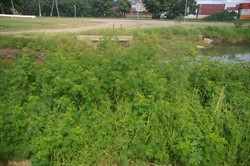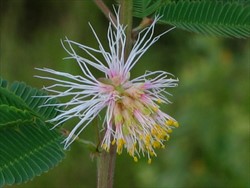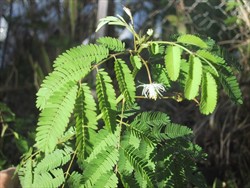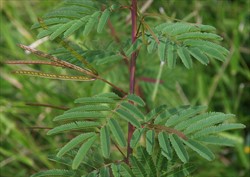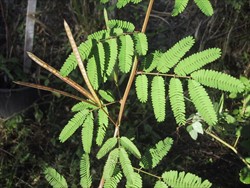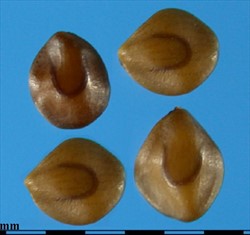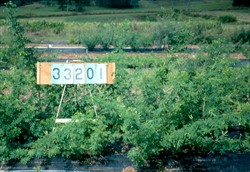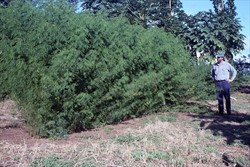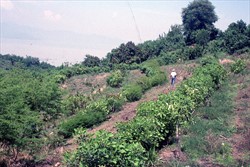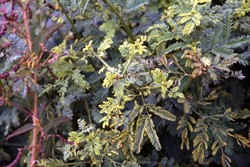Desmanthus pernambucanus
Tropical Forages
Desmanthus pernambucanus (L.) Thellung
Note: Many references to Desmanthus virgatus, [1] [2] [3] even in recent literature, actually refer to D. pernambucanus. Turner (1950) regarded Desmanthus virgatus as [1] [2] [3] an all-encompassing species, comprising D. virgatus [1] [2] [3], D. pubescens, D. pernambucanus, D. glandulosus and D. leptophyllus. Despite taxonomic revision by Luckow (1993) that resolved the complex to distinct species, many authors continued to refer to all species as D. virgatus [1] [2] [3] in the literature until the late 1990s. Correct nomenclature is now generally used.
Basionym: Mimosa pernambucana L.
Family: Fabaceae (alt. Leguminosae) subfamily: Caesalpinioideae (mimosoid clade*) tribe: Mimoseae.
* Azani, N. et al. [97 authors from 54 institutions] 2017. A new subfamily classification of the Leguminosae based on a taxonomically comprehensive phylogeny. Taxon 66: 44–77.
Erect to decumbent perennial herbs or subshrubs, mostly 0.5–1.5 (– 3.0) m tall, little branched from the base. Plants sometimes short-lived, dying after 2–5 years. Young stems angled, red or green with golden corky ridges, sparsely pubescent, pithy centre; older stems terete, red or brown, shiny, glabrous. Stipules persistent, 3–6 mm long, setiform with broad, nerved auricles at the base. Leaves paribipinnate, 4–11 cm long, petiole 6–16 mm long, rachis 10–49 mm long, sparsely pubescent; pinnae (1–) 2–4 (–7) pairs, 15–54 mm long; nectary (gland), 1–3 mm wide, elliptical, flattened or crateriform, inserted on the rachis between the lowest pair of pinnae, each pinna bearing (6–) 9–21(–25) pairs of oblong to linear pinnules, 5–11 mm long and 1.2–3.5 mm wide, ciliate along margin, slightly asymmetric, base truncate, apex acute, exhibiting nyctinastic leaf movement. Capitulum (flower head) axillary, borne singly on peduncles 10–45 mm long, whitish, about 10 mm long and 5 mm across, comprising 8–13 flowers, upper ones perfect (bisexual), lower ones male or sterile. Fruiting peduncles 24–56 mm long, bearing (1–) 5–10 (–13) pods. Pods 45–85 (–115) mm long, 3–4 mm wide, linear, straight or slightly curved, tip mostly acute (rarely beaked); very dark brown at maturity, dehiscent along both sutures; valves somewhat wrinkled with raised reticulate veins; 13–22 seeds per pod. Seeds dark brown, 2.4–3.2 mm long, 1.9–2.4 mm wide, 13–22 per pod. 210,000–310,000 seeds/kg.
Similar species
Desmanthus pernambucanus: erect to decumbent perennial herbs/subshrubs, mostly 0.5–2 m tall; petioles of mature leaves 6–16 mm long; pinnae 2–4 pairs (nectary between lowermost pair); pinnules 9–21 pairs.
Desmanthus glandulosus: erect or occasionally decumbent perennial herb to 0.7 m tall; petiole of mature leaves 4‒10 mm long; pinnae 3‒6 pairs (multiple nectaries common); pinnules 14–26 pairs.
Desmanthus leptophyllus: erect (rarely prostrate or decumbent) shrub 0.4–3 m tall; petioles of mature leaves 3–14 mm long; pinnae 4–8 pairs (nectary between lowermost pair); pinnules 16–36 pairs.
Desmanthus virgatus: prostrate, decumbent or erect subshrubs, typically to 1.5 m tall; petioles of mature leaves 1–5 mm long; pinnae 2–5 pairs (nectary between lowermost pair); pinnules 11–23 pairs.
Asia: 合欢草 he huan cao (Chinese); タチクサネム (Japanese); ไมยรา maiyara (Thailand)
English: slender mimosa, pigeon bundleflower, donkey bean, wild-tantan; dwarf koa (Hawaii); hedge lucerne, ground tamarind (India)
French: acacia courant, acacia savane, petit acacia, pompon blanc (Lesser Antilles); langalet (Haiti)
India: வேலி மசால் velimasal (Tamil); dashrath grass
Latin America: anil, jureminha (Brazil); anil, añil (anil = indigo in Spansih and Portuguese; also applied to Indigofera suffuticosa)
Note: Many early and some more recent publications have misapplied the name, D. virgatus[1] [2] [3], to D. pernambucanus, leading to misidentification in common names, i.e. common names now applied to D. virgatus[1] [2] [3], may well be referring to D. pernambucanus. In such cases the plant should be referred to as Desmanthus virgatus auct[1] [2] [3]., non (L.) Willd.
Native:
Caribbean: Anguilla; Antigua and Barbuda; Aruba; Barbados; Bahamas; Bermuda; Cuba; Dominican Republic; Grenada; Guadeloupe; Haiti; Martinique; Montserrat; Puerto Rico; St. Kitts and Nevis; St. Lucia; St. Vincent and Grenadines; Trinidad and Tobago (Tobago); Virgin Islands (British & U.S.)
South America: Brazil (Bahia, Mato Grosso do Sul, Paraíba, Pernambuco, Piauí, Rio de Janeiro); Guyana; Suriname; Uruguay; Venezuela
Cultivated/naturalized:
Most widely cultivated and naturalized species of the complex formally known as D. virgatus[1] [2] [3]. China (Guangdong, Taiwan, Yunnan); Pacific and Indian Ocean Islands; eastern Australia; southern Africa; south-east Asia; USA (Florida). It appeared in floras of India dating back to the 19th century, and in Thailand as early as 1922.
Forage
D. pernambucanus is an ideal species to establish in pure stand protein banks, but may not be as well-suited to mixed pasture. It has limitations for hay production due to the woody older stems and leaf drop during curing, but if the fallen leaf can be collected, it provides excellent leaf meal.
Environment
It is a good nitrogen fixer and is used as green manure and cover crop. D. pernambucanus has been used in hedgerows in alley farming systems for many years, for soil conservation, soil improvement as well as for stock feed.
Other
Has been shown to be an efficient nursery-stage host for sandalwood (Santalum album L.).
Soil requirements
Occurs naturally on sandy, rocky, limestone and saline soils. In cultivation, it has grown well on a wide range of soils, from clays and hard setting clay loams, including duplex podzolics, to sandy soils, with pH values ranging from 5 to 8, with best performance on near neutral to alkaline soils with a relatively high Ca++ saturation. It is quite salt tolerant, growing into tidal zone in some Pacific islands. In these situations, it does not spread from the coralline strand to the adjacent very acid soils of the centre of the island.
Moisture
Grows in moist roadside situations, ditches, coastal thickets and along the edges of marshes. Limited annual rainfall data at collection sites range from 420 to 875 mm, often with pronounced dry season. D. pernambucanus is being used in areas with a rainfall range of 700‒2,000 (‒3,000) mm/yr. It is tolerant of moderately poor drainage and generally not as drought-hardy as D. leptophyllus. In India, it is grown under irrigation and as a rainfed crop during June‒October.
Temperature
Found in the tropics from 0 to 100 (‒1,500) m asl. Green tissue is killed by frost, but plants regrow from old wood and to some extent from the base.
Light
D. pernambucanus prefers full light and can tolerate open shade, but does not grow under a closed canopy.
Reproductive development
Flowers throughout the year, with peaks from October to March in the northern hemisphere and August to January in the southern hemisphere. Flowers 45–50 days after cutting.
Defoliation
Not usually thought of as being suitable for heavy grazing because of brittle, pithy stems. For cut-and-carry, should be trimmed initially some 60–90 days after sowing to encourage branching. Once the framework is developed, it can be cut every 35–45 days at 30–60 cm. Higher yields but more indigestible component by cutting at less frequent intervals.
Fire
No information available.
Guidelines for establishment and management of sown forages.
Establishment
There are usually high levels of hard seed. For experimental purposes, treatment with concentrated sulphuric acid (200 ml/kg seed) for 8 minutes followed by thorough washing is sufficient to scarify the seed. For larger samples, mechanical or hot water (into boiling water, immediately removed from heat source, and into cool water after 4‒5 minutes) scarification is necessary. A sowing rate of 2–5 kg/ha is adequate, 1–1.5 cm deep. D. pernambucanus may be more promiscuous than other Desmanthus spp., but seed should be inoculated with an appropriate strain of Bradyrhizobium such as CB 3126. To ensure dense stands, sowing rates as high as 20 kg/ha are recommended in India.
Fertilizer
Apply fertilizer according to soil test recommendations. In the absence of soil test results, the standard recommendation for irrigated "hedge lucerne" in India is to apply a dressing of 25:40:20 kg/ha NPK before sowing, and a further 45:60:40 kg/ha after the first cut. Such high levels of fertilizer are usually not warranted in fertile soils or on dryland sowings, particularly nitrogen if the seed has been inoculated with an effective rhizobial strain.
Compatibility (with other species)
Successful in hedgerows because generally not as tall as other hedgerow species such as Desmodium cinereum. Normally not planted in mixture with grass, but could establish grass between rows of D. pernambucanus. Too intolerant of shade to plant under trees.
Companion species
Grasses: Megathyrsus maximus × M. infestus, U. brizantha, Urochloa decumbens.
Legumes: Clitoria ternatea, Stylosanthes hamata.
Pests and diseases
Attacked in Australia by a psyllid, Acizzia sp., which strongly resembles the leucaena psyllid (Heteropsylla cubana). This causes distortion and chlorosis of the young growth, and although weakening, does not kill the plant. There are no other serious pests or diseases recorded.
Ability to spread
D. pernambucanus is extensively naturalized beyond its native distribution suggesting a sound capacity for spread, favoured by copious seed production.
Weed potential
Rated as "invasive" on many of the Pacific Islands including the Hawaiian Islands, French Polynesia, Fiji Islands, Federated States of Micronesia, New Caledonia, Guam and Palau.
Nutritive value
CP content of edible dry matter from 11 to 16%. Leaves >20% CP, 0.8% Ca, and 0.2% P. There is some question as to its value for feeding pigs.
Palatability/acceptability
Eaten by all classes of livestock, but not as palatable as Leucaena leucocephala. Grazing cattle will generally select companion grasses in preference to Desmanthus spp. over the growing season, but Desmanthus spp. are generally well accepted. However, D. pernambucanus is most suited to cut-and-carry feeding systems and is well accepted by stall-fed ruminants.
Toxicity
No reported toxicities to ruminant livestock. Desmanthus spp. do not cause bloat in ruminants because they contain 2–3% (of total DM as tannic acid equivalent) condensed tannins.
Dry matter
Yields of up to 38 t/ha DM have been recorded when monocropped, but more commonly in the range of 10–20 t/ha DM.
Animal production
When fed as a supplement to cattle, can raise average daily liveweight gain by >65%.
2n = 26, 28. Most plant improvement in this species was initially achieved through a process of selection among accessions within wild-type collections. The next stage in this process has been to revisit old evaluation sites to collect surviving phenotypes with followup testing for genetic shift from original populations. Analysis of a range of Desmanthus species including a number of accessions of D. pernambucanus using random amplified polymorphic DNA (RAPD) marker technique indicated that the non-American (Mauritius, Fiji, Hawaii, New Caledonia and India) D. pernambucanus germplasm probably originated from Brazil.
Hand-harvested seed yields of 1‒2 t/ha have been obtained from various lines of D. pernambucanus in Thailand, the highest yields from CPI 52401.
Herbicide tolerances observed for D. virgatus [1] [2] [3] may be applicable to this related species. It was largely tolerant of the pre-emergent herbicides, imazaquin, imazethapyr, pendimethalin, oryzalin and trifluralin, and the post-emergent herbicides, haloxyfop, clethodim, propyzamide, carbetamide and dalapon. Selective post-emergence control of broad-leaved weeds can be achieved using bentazone, bromoxynil or imazethapyr. Atrazine, terbacil and hexazinone may have some potential for controlling mature perennial weeds in second-year seed crops.
- Adapted to alkaline soils.
- High yielding.
- Prolific seed production.
- Salt tolerant.
- Drought tolerant.
- Not suitable for mixed grass-legume pastures.
- Not tolerant of heavy grazing.
- Some weed potential.
Burt, R.L. (1993) Desmanthus: a tropical and subtropical forage legume. Part 1. General Review. Herbage Abstracts 63:401–413.
Burt, R.L. (2016) Searching for pasture legumes for heavy clay soils in Australian dry tropics and subtropics: IV. Evaluation in Western Queensland. In: Lazier, J.R. and Ahmad, N. (eds) Tropical forage legumes: Harnessing the potential of Desmanthus and other genera for heavy clay soils. CAB International, Wallingford, Oxon, UK. p. 204–253. doi.org/10.1079/9781780646282.0204
Cox, K.G. and Harrington, K.C. (2005) Selective herbicide strategies for use in Australian Desmanthus seed crops. Tropical Grasslands 39:171–181. bit.ly/2WNQC7G
Gardiner, C.P., Ossiya, S.A. and Rangel, J.H.A. (2017) Discontinued legume trials yield potentially valuable genotypes. Proceedings of the 18th Australian Society of Agronomy Conference. Ballarat, Australia, 24–28 September 2017. bit.ly/2JkWv4n
Jones, R.M. and Brandon, N.J. (1998) Persistence and productivity of eight accessions of Desmanthus virgatus under [1] [2] [3] a range of grazing pressures in subtropical Queensland. Tropical Grasslands 32:145–152. bit.ly/39luAvP
Luckow, M. (1993) Monograph of Desmanthus (Leguminosae-Mimosoideae). Systematic Botany Monographs Vol. 38. American Society of Plant Taxonomists, Laramie, WY, USA. doi.org/10.2307/25027822
Pengelly, B.C. and Liu, C.J. (2001) Genetic relationships and variation in the tropical mimosoid legume Desmanthus assessed by random amplified polymorphic DNA. Genetic Resources and Crop Evolution 48:93–101. doi.org/10.1023/A:1011234913710
Turner, B.L. (1950) Texas species of Desmanthus (Leguminosae). Field and Laboratory 18:54–65.
‘Chaland’ (CPI 52401) Released in Thailand. See "Promising accessions". Grows best in the wet tropics in areas with short dry season but can survive long dry season. Has performed well in other SE Asian countries and Australia.
'JCU 9' Granted PBR protection in Queensland, Australia (2018).
'TNDV-1' Released in Tamil Nadu, India.
CPI 30205 Selected in Queensland, Australia. Origin unknown; institutional collection from Coimbatore, India, where used as a green manure and soil cover crop. High yielding, widely adapted.
CPI 33201 Selected in Queensland, Australia. Origin Guadeloupe (15º57' N, altitude 20 m asl, rainfall 1,800 mm). High yielding, widely adapted.
CPI 40071 Selected in Queensland, Australia and Vanuatu. Origin near Vertentes, Pernambuco, Brazil (7º55' S, 390 m asl, rainfall 636 mm). High yielding, widely adapted. Produced 5–7 t/ha/yr DM in small plot trials in Vanuatu.
CPI 49728 Selected in Queensland, Australia. Origin unknown; institutional collection from Cruz das Almas, Brazil. High yielding, widely adapted
CPI 52401 Selected in Chainat, Thailand. Origin unknown, collected Mahebourg, Mauritius (20°27' S, 5 m asl, rainfall 1,750 mm). High DM (>5 t/ha) and seed yields (c. 2 t/ha). (See also cv. Chaland.)
CPI 55718 Selected in Queensland, Australia. Origin Bahia, Brazil (10º44' S, 390 m asl, rainfall 590 mm). High yielding, widely adapted.
